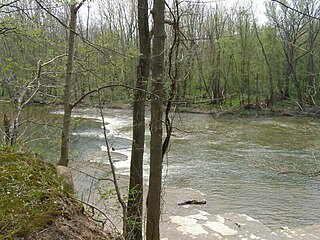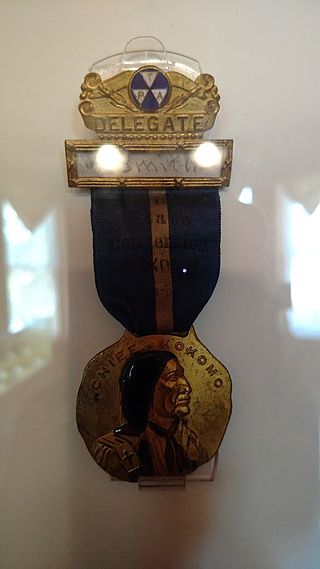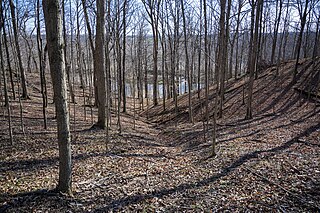
Fairfield is a city in southern Butler County, Ohio, United States. It is a suburb located about 25 miles (40 km) north of Cincinnati and is situated on the east bank of the Great Miami River. The population was 44,907 as of the 2020 census. Incorporated in 1955 from portions of Fairfield Township, it includes the former hamlets of Symmes Corner, Fair Play, Furmandale, and Stockton. The Fairfield City School District is one of the largest in Ohio and serves both the City of Fairfield and Fairfield Township.

Miami County is a county located in east-central Kansas and is part of the Kansas City metropolitan area. Its county seat and most populous city is Paola. As of the 2020 census, the county population was 34,191. The county was named for the Miami tribe.

Porter County is a county in the U.S. state of Indiana. As of 2020, the population was 173,215, making it the 10th most populous county in Indiana. The county seat is Valparaiso. The county is part of Northwest Indiana, as well as the Chicago metropolitan area. Porter County is the site of much of the Indiana Dunes, an area of ecological significance. The Hour Glass Museum in Ogden Dunes documents the region's ecological significance.

Miami County is a county located in the U.S. state of Indiana. As of 2020, the population was 35,962. The county seat is the City of Peru. Miami County is part of the Kokomo-Peru CSA.

Franklin County is a county on the eastern border of the U.S. state of Indiana. In the 2020 United States Census, the county population was 22,785. The county seat is the town of Brookville. Franklin County is part of the Cincinnati, OH–KY–IN Metropolitan Statistical Area. The only incorporated city in Franklin County is Batesville, which lies mostly in adjoining Ripley County.

The Miami are a Native American nation originally speaking one of the Algonquian languages. Among the peoples known as the Great Lakes tribes, they occupied territory that is now identified as north-central Indiana, southwest Michigan, and western Ohio. The Miami were historically made up of several prominent subgroups, including the Piankeshaw, Wea, Pepikokia, Kilatika, Mengakonkia, and Atchakangouen. In modern times, Miami is used more specifically to refer to the Atchakangouen. By 1846, most of the Miami had been forcefully displaced to Indian Territory. The Miami Tribe of Oklahoma are the federally recognized tribe of Miami Indians in the United States. The Miami Nation of Indiana, a nonprofit organization of descendants of Miamis who were exempted from removal, have unsuccessfully sought separate recognition.

Peru is a city in, and the county seat of, Miami County, Indiana, United States. It is 73 miles (117 km) north of Indianapolis. The population was 11,073 at the 2020 census, making it the most populous community in Miami County. Peru is located along the Wabash River and is part of the Kokomo-Peru Combined Statistical Area.

Frances Slocum was an adopted member of the Miami people. Slocum was born into a Quaker family that migrated from Warwick, Rhode Island, in 1777 to the Wyoming Valley in Luzerne County, Pennsylvania. On November 2, 1778, when Slocum was five years old, she was captured by three Delaware warriors at the Slocum family farm in Wilkes-Barre, Pennsylvania. Slocum was raised among the Delaware in what is now Ohio and Indiana. With her marriage to Shepoconah, who later became a Miami chief, Slocum joined the Miami and took the name Maconaquah. She settled with her Miami family at Deaf Man's village along the Mississinewa River near Peru, Indiana.

Shandon is an unincorporated community in southwestern Morgan Township, Butler County, Ohio, United States. It is located on Paddy's Run, a tributary of the Great Miami River, about four miles west of Ross at the intersection of State Routes 126 and 748 in section 25 of R1ET3N of the Congress Lands. It was originally called Glendower as the town was settled by immigrants from Wales. It was later called New London and this survives in the names of Alert-New London and Hamilton-New London Roads. The town is in the Ross Local School District.

The Mississinewa River is a tributary of the Wabash River in eastern Indiana and a small portion of western Ohio in the United States. It is 120 miles (190 km) long and is the third largest tributary behind the White and Little Wabash Rivers, only slightly larger than the Embarras and Vermilion Rivers. Via the Wabash and Ohio rivers, it is part of the Mississippi River watershed.

Kokomo, whose name is also sometimes given as Koh-Koh-Mah, Co-come-wah, Ma-Ko-Ko-Mo, or Kokomoko, was a Native American man of the Miami tribe who lived in northern Indiana at some point probably in the early nineteenth century. The city of Kokomo, Indiana is named after him. David Foster, the founder of the city of Kokomo, is widely quoted as having said, "It was the orneriest town on earth, so I named it after the orneriest Indian on earth—called it Kokomo," but this anecdote may be apocryphal and it is unclear whether Foster was the one who proposed the name for the city at all.

Butler Township is one of fourteen townships in Miami County, Indiana, United States. As of the 2010 census, its population was 866 and it contained 396 housing units.

Erie Township is one of fourteen townships in Miami County, Indiana, United States. As of the 2010 census, its population was 554 and it contained 242 housing units. The township's only community is Erie.

Washington Township is one of fourteen townships in Miami County, Indiana, United States. As of the 2010 census, its population was 3,493 and it contained 1,630 housing units.

Waltz Township is one of seven townships in Wabash County, Indiana, United States. As of the 2010 census, its population was 1,287 and it contained 572 housing units.

Vallonia is an unincorporated community and census-designated place (CDP) in Driftwood and Brownstown townships, Jackson County, Indiana, United States. It was an 18th-century French settlement and 19th-century American frontier fortification known as Fort Vallonia. As of the 2010 census, Vallonia had a population of 336.

Drums is an unincorporated community in Butler Township, Luzerne County, Pennsylvania. Located about 1,500 feet (460 m) altitude in the Sugarloaf Valley, it is situated east of Interstate 81 and north of Nescopeck Creek, a tributary of the Susquehanna River. It was founded by the Drum family in the late 18th century and was originally known as Drum's. Its ZIP Code is 18222, served by the 788 exchange in Area Code 570.

The Miami Nation of Indiana is a group of individuals who identify as Miami and have organized as a 501(c)(3) nonprofit organization. The group's headquarters are at Peru, Indiana.

Frances Slocum State Forest is 516 acres of natural land managed by the Indiana Department of Natural Resources.
Peoria Cemetery records, held by the Peoria Cemetery Board and sexton.
Peoria Church records, located at the Church, 5575 E 325 S, Peru, Indiana, 46970.




















